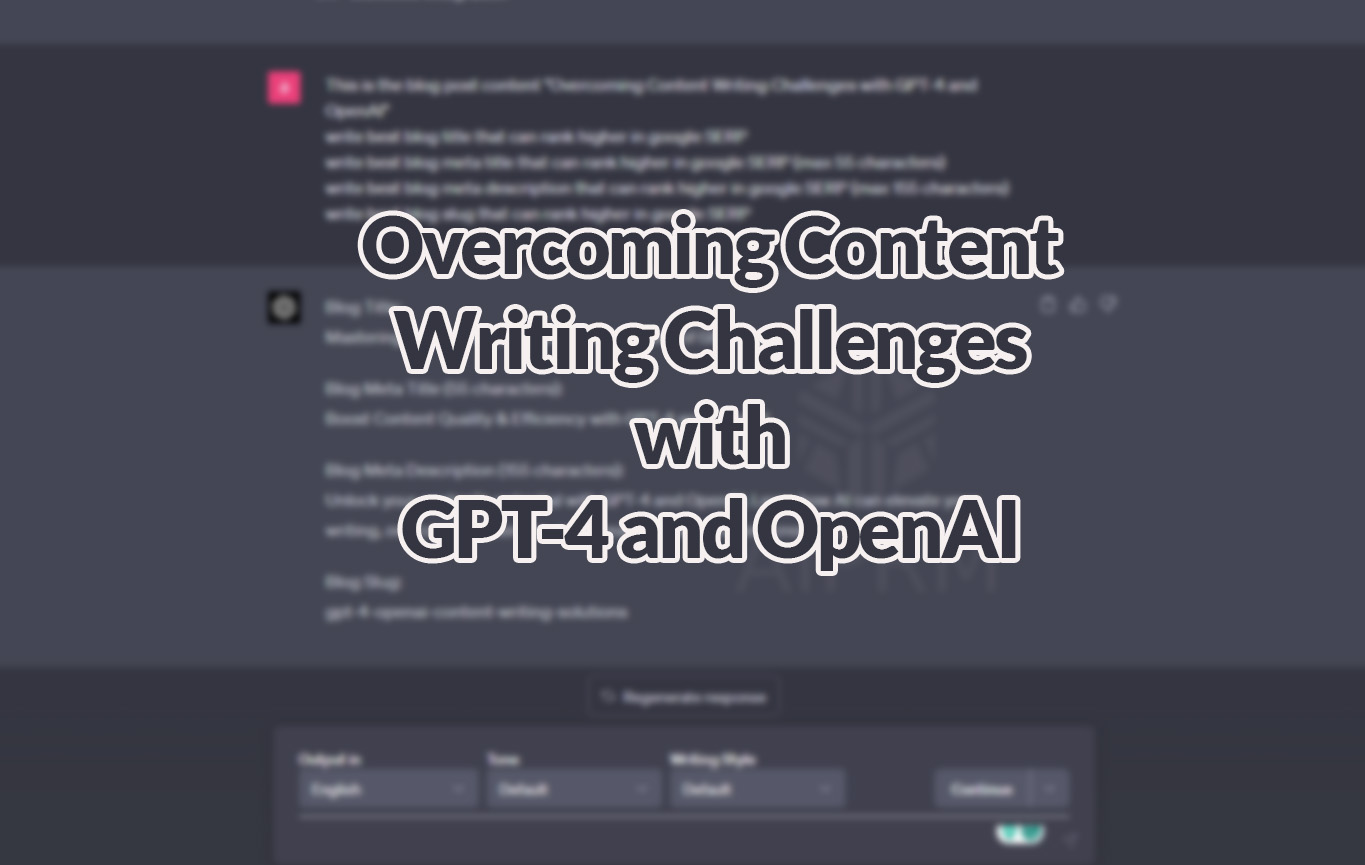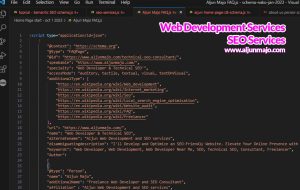Overcoming Content Writing Challenges with GPT-4 and OpenAI

There’s no denying it, content writing can be a tough nut to crack. You’re constantly wracking your brain for fresh ideas and engaging ways to present them, all while trying to keep up with the ever-evolving landscape of digital marketing. But what if I told you there’s an ace up our sleeve that could help you conquer these challenges like never before? Enter GPT-4, OpenAI’s latest language model that’s making waves in the world of content creation.
Imagine having access to a tool capable of generating high-quality text almost indistinguishable from a human-written copy but at lightning-fast speeds! Well, folks, this isn’t just some pipe dream anymore – it’s becoming a reality through the power of artificial intelligence (AI). In today’s article, I’ll dive deep into how GPT-4 and OpenAI are revolutionizing content writing and helping writers like yourself to achieve mastery over those pesky creative hurdles. So buckle up and get ready for an eye-opening ride down AI lane!
Need an AI-assisted Freelance Content Writer?
Understanding GPT-4 And Openai’s Capabilities
Diving into the world of content writing, you may sometimes feel overwhelmed by the sheer volume of work and the constant demand for fresh ideas. You might wonder if there’s a secret weapon out there to help streamline your workflow and conquer writer’s block once and for all. Enter GPT-4, OpenAI’s revolutionary artificial intelligence tool that has been transforming content creation across various industries.
GPT-4 is an AI-powered language model developed by OpenAI, designed to generate human-like text with minimal input from users. This cutting-edge technology can not only save time but also improve efficiency in producing high-quality content at scale. By integrating this powerful tool into your content writing process, you can unlock new levels of mastery over your craft while staying ahead of industry trends.
As we continue navigating the ever-evolving landscape of content writing, it becomes crucial to adapt to emerging technologies like artificial intelligence. With GPT-4 and OpenAI at our disposal, we have access to tools that enable us to create better content faster than ever before – without sacrificing quality or authenticity. The seamless workflow integration provided by these advancements empowers writers and businesses alike to achieve their goals more efficiently.
Harnessing the power of GPT-4 doesn’t require extensive technical knowledge or expertise; its user-friendly interface makes it easy for anyone passionate about crafting engaging stories to get started right away. Now let’s delve deeper into how GPT-4 addresses common content writing challenges and elevates your skills beyond what was previously thought possible.
How GPT-4 Addresses Common Content Writing Challenges
Imagine effortlessly overcoming those persistent writing challenges that have been holding you back from creating the perfect piece of content. With GPT-4, AI-assisted writing is no longer a dream but a reality. This revolutionary technology addresses many common issues faced by writers and provides the much-needed support to elevate their content creation game.
One major concern for writers is maintaining creativity while producing consistent, high-quality work. GPT-4 steps in as an invaluable creative partner, offering suggestions and insights that can spark new ideas or help refine existing concepts. By generating contextually relevant content at scale, this cutting-edge model allows users to break free from writer’s block and explore fresh perspectives on any topic imaginable.
Efficiency is another challenge that plagues the world of content creation. Writers often struggle with time management, striving to produce quality work within tight deadlines. Enter GPT-4: its ability to generate large volumes of coherent text quickly makes it an ally for those looking to save valuable hours without sacrificing substance or style. By automating aspects of the writing process, OpenAI’s groundbreaking language model empowers writers to focus on shaping narratives and fine-tuning prose rather than getting bogged down in research and ideation.
As we’ve seen, GPT-4 has already proven itself capable of transforming how we approach these common writing challenges—unleashing newfound levels of creativity and efficiency along the way! But there’s even more potential waiting just around the corner; let us now delve into ways one can enhance both creativity and efficiency through GPT-4 assisted writing techniques.
Enhancing Creativity And Efficiency With GPT-4 Assisted Writing
Picture yourself sitting in front of your computer, fingers hovering over the keyboard, eyes locked onto a blank screen. The pressure to create engaging content is mounting as deadlines loom, and creativity seems to have gone on vacation. But what if there was a secret weapon waiting to be unleashed? Enter GPT-4 by OpenAI – an advanced language model that’s ready to revolutionize the way you approach writing.
The power of GPT-4 lies in its ability to generate text that mimics human-like thought processes and linguistic patterns. This means it can provide insightful suggestions for expanding upon ideas or presenting them from different angles – perfect for when writer’s block hits hard. By simply inputting a prompt or topic, users can leverage this AI-driven technology to come up with captivating stories or unique perspectives they may not have considered otherwise. It’s like having an entire team of skilled writers at your disposal, all working together towards crafting compelling narratives and delivering fresh insights.
In addition to sparking creative inspiration, GPT-4 offers numerous benefits when it comes to efficiency. With its lightning-fast response time and seamless integration into existing workflows, content creators no longer need to wrestle with unwieldy sentences or spend precious hours searching for just the right word. Instead, they can focus on refining their message while letting the AI handle much of the heavy lifting. Time-consuming tasks such as editing and proofreading become less daunting affairs as GPT-4 provides valuable feedback on grammar, structure, and tone – ensuring each piece achieves clarity without sacrificing personality.
As I’ve seen throughout this section, harnessing the capabilities of GPT-4 transforms both creativity and efficiency within our writing endeavors. Its powerful assistance allows us not only to overcome challenges but also to thrive in producing exceptional content capable of capturing readers’ attention and fulfilling that innate desire for mastery. Let’s now explore how best one might integrate G finally-4 into their own content creation process, unlocking a world of potential that awaits.
Integrating GPT-4 Into Your Content Creation Workflow
Delving into the intricacies of GPT-4 integration, one must acknowledge its transformative potential in revolutionizing content creation workflows. The seamless fusion of artificial intelligence and human creativity can yield unparalleled results, driving efficiency without compromising quality. By incorporating GPT-4 into your content strategy, you are poised to achieve mastery in crafting compelling narratives that captivate audiences.
The first step towards harnessing the power of GPT-4 is understanding its capabilities and limitations. While this AI-driven tool exhibits an impressive ability to generate coherent text based on prompts, it remains essential for creators to maintain control over their work, applying critical thinking skills to refine output as necessary. Developing a symbiotic relationship with GPT-4 will empower writers to maximize productivity while retaining their unique voice and perspective.
As you embark upon integrating GPT-4 into your workflow, consider adopting a tailored approach that aligns with your specific objectives. For instance, leveraging the model’s prowess in rapid ideation can help break through writer’s block or bolster brainstorming sessions by providing fresh perspectives on familiar topics. Additionally, utilizing GPT-4 to draft initial versions of articles allows for increased focus on editing and refining core messaging – elevating the overall quality of published works.
Creating synergy between human intuition and advanced technology like GPT-4 paves the way for innovative solutions within the realm of content creation. Embracing these advancements provides opportunities not only for enhanced efficiency but also for personal growth as individuals adapt and evolve alongside cutting-edge tools at their disposal. With such integration complete, we now turn our attention toward best practices and tips designed specifically to amplify your success when working with GPT-4’s vast array of possibilities.
Est Practices And Tips For Harnessing GPT-4’s Full Potential
Imagine the boundless possibilities that lie ahead as you master GPT-4’s phenomenal capabilities. The excitement of creating captivating content with ease, transforming your writing process, and leaving readers in awe. Let’s dive into best practices and tips to help you harness GPT-4’s full potential and turn this dream into reality.
Firstly, understanding the input-output relationship is crucial for achieving desired results. Be mindful of how you frame your prompts; specificity matters! Use explicit instructions while still allowing room for creativity. Remember, the better defined your query is, the more accurate and useful GPT-4’s response will be. Experimenting with various phrasings can make a significant difference when aiming for mastery.
Secondly, establish an iterative approach to refine output from GPT-4; perfection may not always emerge in one go – but fear not! Reaping its benefits involves patience and adaptability. Embrace this opportunity to hone your editing skills by adjusting prompts or employing user feedback to achieve optimal outcomes. Working hand-in-hand with GPT-4 means growth both for yourself and the AI model.
As we part ways on this transformative journey, let us reflect upon our shared enthusiasm for embracing challenges head-on, fueled by a burning desire to excel at content creation using OpenAI’s groundbreaking technology. May these best practices serve as guiding lights toward a future where human ingenuity harmoniously intertwines with artificial intelligence — unlocking uncharted territories brimming with untapped potential.
Conclusion
In conclusion, the potential of GPT-4 and OpenAI in the content creation process is undoubtedly immense. As content creators, it is our duty to harness the power of these advanced tools to overcome challenges, enhance creativity, and boost efficiency. This technology provides us with the opportunity to unlock new levels of mastery in our craft, all while staying ahead of the curve in the ever-changing digital landscape.
As a Freelance Web Developer and Technical SEO with experience using GPT-4 for writing content, I can attest to the transformative impact of this groundbreaking technology on my work. If you need assistance or want to leverage the power of GPT-4 for your content strategy, feel free to message me. Together, we can elevate your content to new heights and position it for higher visibility in Google search results.
The future of content creation is indeed bright as we embrace the harmonious collaboration between human ingenuity and artificial intelligence. By following best practices and harnessing GPT-4’s full potential, we can create content that captivates audiences and propels our success in the digital space. This is the time to be proactive, innovative, and unafraid of exploring new possibilities.
As you embark on your own journey with GPT-4, I encourage you to remember the importance of continual growth and adaptation. The future of content creation lies in our ability to meld our expertise with the power of AI-driven tools like GPT-4. Let us take the first steps together towards a realm where creativity and technology harmoniously coexist, pushing the boundaries of what we once thought possible.


